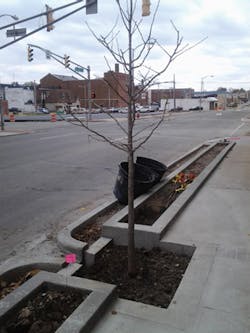Pavers Prove Valuable in Stormwater Solutions
Unanticipated Stormwater Surprise
At Chuck’s Produce in Vancouver, WA, the family-owned grocery has a mission to provide fine specialty foods—many organically grown—with varieties catering to the most sophisticated epicurean and to the family dinner table. The store’s motto, “You never go wrong doing the right things,” translates to both the products and service indoors, and to the aesthetics and environmental sensitivity of the hardscape outdoors.
John Meier, P.E., of Vancouver-based AKS Engineering and Forestry says installing 15,000 square feet of permeable EcoPriora pavers at the site “wasn’t easy, but it was a fun project.”
The site had stormwater runoff issues, a sticky problem the owners discovered as they were preparing to build the 45,000-square-foot retail store.
“It turned out the facility was oversized for the proposed stormwater plans, so alternative solutions had to be found to manage stormwater onsite. The property happens to be within a critical aquifer recharge area with a wellhead across the street; we were limited on the type of infiltration we could do onsite,” says Meier.
The receiving water for runoff from Chuck’s Produce is the Salmon Creek, which, he says, “is a fish-bearing stream requiring enhanced water-quality treatment.
“We had two options for stormwater: permeable pavers or rain gardens. So, we did both,” says Meier.
“The aesthetics of the property were very important to the owners. They wanted the grounds and exterior to convey the same message and feel of quality, environmental sensitivity, and community interest outdoors as they do inside the store.”
Meier says the county had recently instituted a fast-track program for urban development. “You could do land-use review and civil engineering at the same time. The site happens to be in an overlay area, and there were new standards for redevelopment. The combined review process was very good, and we had a good team of owner, consulting engineer, and contractor.”
Instead of building a pond, the owners had options of concrete, asphalt, or pavers, but the owners liked the look of the pavers. In view of the long-term survivability and ease of maintenance over other products, “it just made sense to go with permeable pavers,” says Meier. But protecting the watershed required additional preparation of the underlying soil.
“We had to have enhanced treatment and had to so some underlying soil amendment, to make sure of the content [so it] would permit a chemical exchange process. We also put down two to three feet of coarse gravel, as the water from the roof of the facility also drains under the pavement and goes to a huge stormwater header pipe.”




